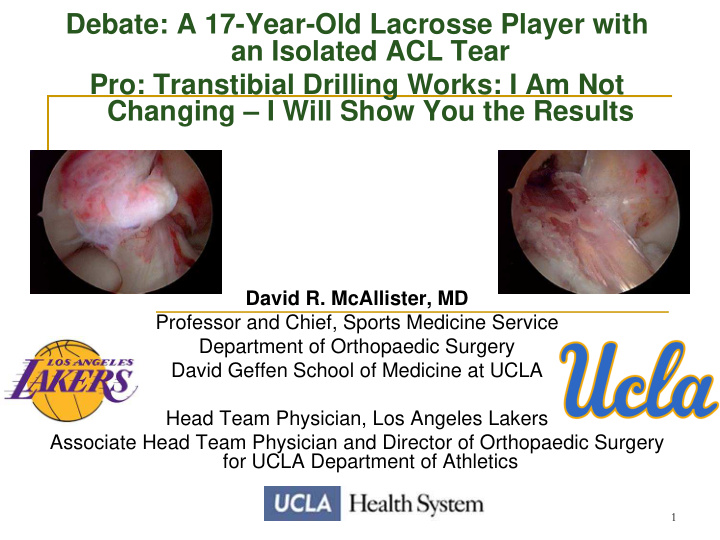



Debate: A 17-Year-Old Lacrosse Player with an Isolated ACL Tear Pro: Transtibial Drilling Works: I Am Not Changing – I Will Show You the Results David R. McAllister, MD Professor and Chief, Sports Medicine Service Department of Orthopaedic Surgery David Geffen School of Medicine at UCLA Head Team Physician, Los Angeles Lakers Associate Head Team Physician and Director of Orthopaedic Surgery for UCLA Department of Athletics 1
Disclosure Biomet: IP royalties; Paid consultant Elsevier: Publishing royalties, financial or material support Musculoskeletal Transplant Foundation/Conmed: Paid consultant Ossur: Paid presenter or speaker Smith & Nephew: Unpaid consultant 2
Normal ACL 3
Recent Trends in ACL Reconstruction: “Anatomic” ACL Reconstruction Lower femoral tunnel position Transtibial vs. AM portal creation of femoral tunnel 4
Is Lower Femoral Tunnel Position Better? A number of surgeons have recently advocated a lower femoral tunnel position as more “anatomic” However, is lower necessarily more “anatomic”? 5
Is Lower Femoral Tunnel Position Better? Does placing the femoral tunnel at 9:30 to 10 o'clock provide the graft with a better mechanical advantage? No change in pivot-shift, kinematics or AP laxity The rationale for placing the femoral tunnel at a more oblique position in the notch to reduce the pivot shift is questioned. Markolf et. al. AJSM 2010 Markolf et. al. JOR 2002 6
Is Lower Femoral Tunnel Position Better? Recent Clinical Study Report of the Danish ACL registry that the revision rate for failed reconstruction for the anteromedial portal technique was two times greater than that for the transtibial technique Wagner et. al. KSSTA 2012 7
Transtibial vs. Anteromedial Reaming of Femoral Tunnel There are multiple studies with conflicting results However, many of the studies favor of anteromedial reaming Bowers et al, Arthroscopy, 2011 Bedi et al, Arthroscopy, 2011 Gadikota, AJSM 2012 8
Transtibial vs. Anteromedial Reaming of Femoral Tunnel The femoral tunnel can be positioned in a highly anatomic manner using a transtibial technique but require careful choice of the tibial starting position. Piasecki et al, AJSM, 2011 The key is to place the femoral tunnel in the correct position regardless of technique 9
Oblique Tibial Tunnel 10
Tibial Tunnel Placement Adjacent to anterior horn of lateral meniscus Native ACL footprint In between the tibial spines 11
Femoral Tunnel Placement As deep in the notch as possible without violation of the posterior cortical wall 1:30 or 10:30 o’clock position within footprint Tunnel that is too vertical has good AP control but will impinge on PCL Lower is not always better! Tunnel that is too low results in high graft tension 12
Femoral Tunnel Placement 12 12 Femoral Tunnel 9 9 13
Femoral Tunnel Preparation Femoral “over the top” aimer Free hand technique 14
Femoral Tunnel Position I sometry D irect Fibers E ccentric/Equidistant A natomic L ow tension Midway between PCL and LFC articular cartilage 1 mm posterior wall 15
Graft Position/No Impingement 16
Femoral Tunnel Position Isometry Direct Fibers Eccentric/Equidistant Anatomic Low tension Midway between PCL and LFC articular cartilage 1 mm posterior wall Pearle et al, AJO 2015 17
Tibial Tunnel Position Within native ACL tibial footprint Adjacent to anterior horn of lateral meniscus In between the tibial spines Avoid notch/roof impingement 18
Graft Position/No Impingement 19
Thank You 20
Recommend
More recommend